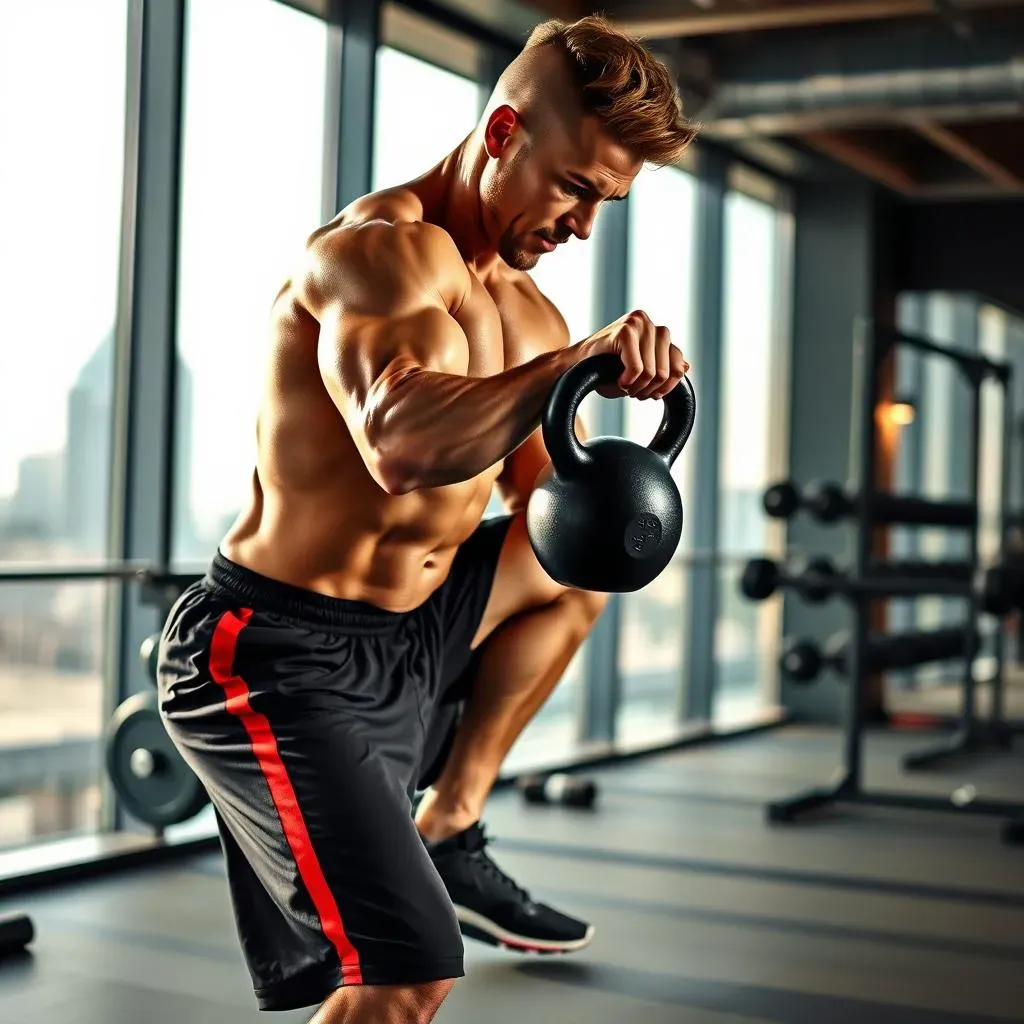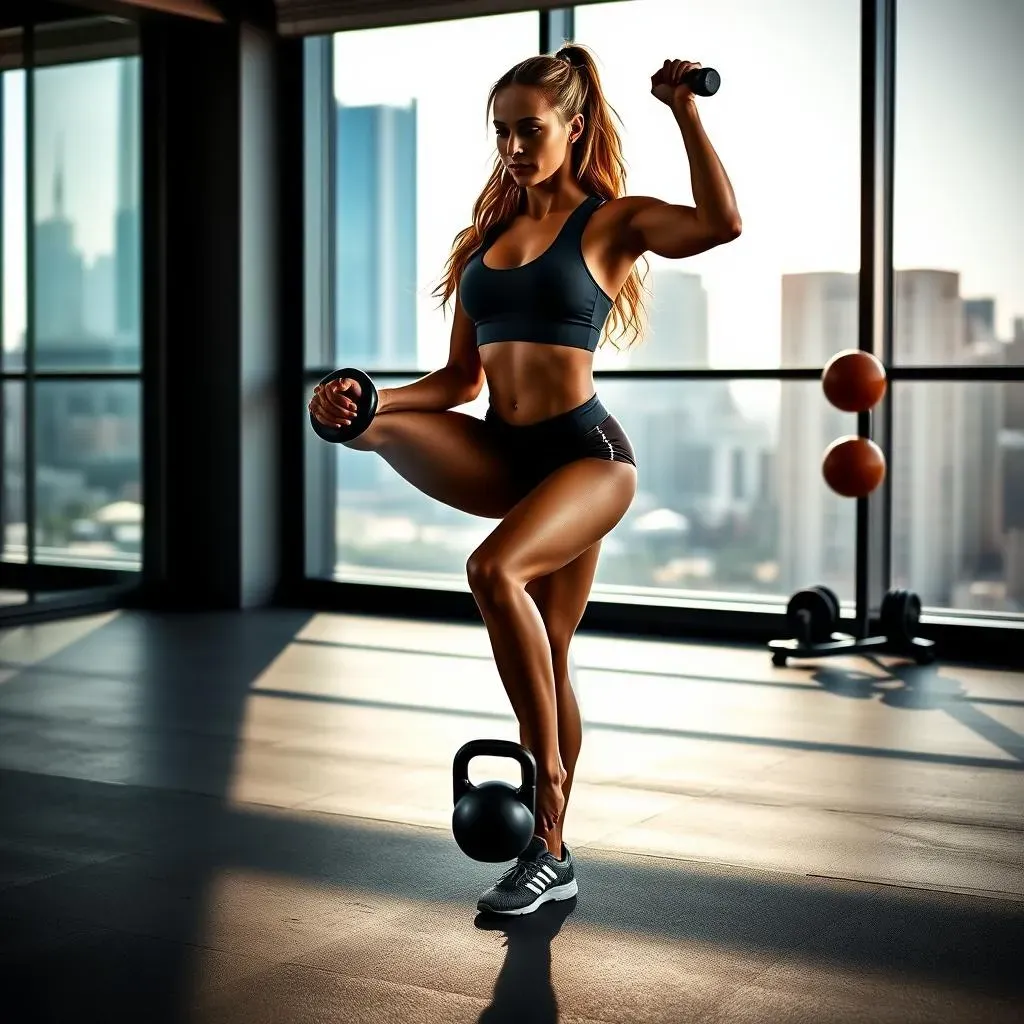Table of Contents
Are you ready to level up your strength training? Forget the days of solely focusing on bilateral movements – it's time to embrace the power of unilateral kettlebell exercises. These aren't just your average workouts; they're a secret weapon for building balanced strength, improving stability, and sculpting a resilient physique. Think of it this way: life rarely happens with both feet planted perfectly even, so why should your training? This article is your comprehensive guide to understanding and implementing unilateral kettlebell exercises into your fitness routine.
Why Unilateral Kettlebell Exercises are a Game Changer

Why Unilateral Kettlebell Exercises are a Game Changer
so you're diving into unilateral kettlebell exercises? Awesome choice! Let's break down why they're such a game-changer. First off, think about how you move in everyday life. You're rarely doing things perfectly symmetrically. You carry groceries on one side, you reach for things with one arm, you step forward with one leg. Unilateral training mimics these real-world movements, making you stronger and more functional in your daily activities.
But it's not just about being practical. Unilateral exercises expose weaknesses and imbalances you might not even know you have. When you're using both limbs together, your stronger side can compensate for the weaker one. But when you force each side to work independently, those discrepancies become glaringly obvious. This allows you to address those weaknesses and build a more balanced and resilient body. Plus, the core activation you get from stabilizing against the offset load is insane! Forget endless crunches; unilateral kettlebell work is a much more effective way to build a strong and stable midsection.
And here's a kicker: it can also help prevent injuries. By strengthening each side independently, you reduce the risk of overcompensation and strain on your joints. This is especially important for athletes or anyone who puts their body through a lot of stress. So, whether you're looking to improve your athletic performance, enhance your everyday functionality, or simply build a more balanced and resilient body, unilateral kettlebell exercises are a powerful tool to add to your arsenal. Trust me, once you start incorporating them, you'll wonder how you ever trained without them!
Top Unilateral Kettlebell Exercises for FullBody Strength

Top Unilateral Kettlebell Exercises for FullBody Strength
#1: The Single-Leg Deadlift: Your Hamstrings' New Best Friend
Alright, let's get to the good stuff! The single-leg deadlift is a fantastic way to target your hamstrings, glutes, and core, all while improving your balance and stability. It's like a regular deadlift, but with a twist – you're doing it on one leg! This forces your body to work overtime to stabilize, engaging muscles you never even knew you had. Plus, it's a great way to identify and correct any imbalances between your left and right sides.
To perform it, stand on one leg with a kettlebell in the opposite hand. Hinge at your hips, keeping your back straight and your core engaged, and lower the kettlebell towards the ground. Only go as far as you can while maintaining good form. Then, drive through your heel to return to the starting position. Start with a lighter weight and focus on mastering the movement before increasing the load. Trust me, your hamstrings will thank you later!
#2: The Suitcase Carry: Grip Strength and Core Stability, All in One
Next up, we have the suitcase carry. Don't let the simplicity fool you; this exercise is a powerhouse for building grip strength, core stability, and overall shoulder health. It's essentially walking with a kettlebell in one hand, but the offset load forces your core to work overtime to prevent you from tilting to one side. This not only strengthens your obliques but also improves your posture and balance.
To do it, simply grab a kettlebell and hold it by your side, like you're carrying a suitcase. Stand tall with your shoulders back and your core engaged, and walk for a set distance or time. Focus on maintaining a straight line from your head to your heels, resisting the urge to lean or slouch. You'll feel your core working hard to keep you upright. Start with a moderate weight and gradually increase the load as you get stronger. This is a great exercise to incorporate into your warm-up or as a finisher at the end of your workout.
#3: The Single-Arm Kettlebell Swing: Power and Coordination Unleashed
Finally, let's talk about the single-arm kettlebell swing. This exercise is a dynamic movement that builds explosive power, improves coordination, and torches calories. It's similar to a regular kettlebell swing, but with one arm, which challenges your core and shoulder stability even more. The single-arm swing is all about generating power from your hips and glutes, not your arms. Think of your arm as a rope that's connected to the kettlebell, and your hips as the engine that's driving the movement.
To perform it, stand with your feet slightly wider than shoulder-width apart and the kettlebell in front of you. Hinge at your hips, grab the kettlebell with one hand, and hike it back between your legs. Then, explosively drive your hips forward, swinging the kettlebell up to chest height. Control the kettlebell as it swings back down, and repeat. Focus on keeping your back straight and your core engaged throughout the movement. This is a great exercise to improve your power output, cardiovascular fitness, and overall athleticism.
Exercise | Muscles Worked | Benefits |
|---|---|---|
Single-Leg Deadlift | Hamstrings, Glutes, Core | Improved balance, stability, and hamstring strength |
Suitcase Carry | Core, Obliques, Grip Strength | Enhanced core stability, posture, and grip strength |
Single-Arm Kettlebell Swing | Hips, Glutes, Core, Shoulders | Increased power, coordination, and cardiovascular fitness |
Mastering Form: Getting the Most Out of Unilateral Kettlebell Training

Mastering Form: Getting the Most Out of Unilateral Kettlebell Training
Alright, so you're ready to dive into unilateral kettlebell work? Awesome! But before you start swinging and snatching with reckless abandon, let's talk about form. Because let's be real, nothing derails progress faster than an injury. And with unilateral exercises, where you're already challenging your stability and balance, proper form is absolutely crucial. It's not just about lifting the weight; it's about controlling the movement and engaging the right muscles.
First things first: master the basics. Before you even think about adding weight or complexity, make sure you've got the fundamental movement patterns down pat. Can you hinge properly at the hips? Can you maintain a neutral spine? Can you engage your core without holding your breath? If the answer to any of those questions is no, then take a step back and focus on building a solid foundation. There are tons of resources online that can help you learn the proper form for basic kettlebell exercises like the swing, the goblet squat, and the Turkish get-up. Once you've got those down, you'll be in a much better position to tackle more advanced unilateral variations.
Now, let's talk about some specific tips for maintaining good form during unilateral kettlebell exercises. One of the most important things is to focus on maintaining a stable base of support. This means keeping your grounded foot firmly planted on the ground and engaging your glutes and core to prevent wobbling or tilting. It also means paying attention to your posture. Keep your shoulders back and down, your chest up, and your head in line with your spine. Avoid rounding your back or hunching your shoulders, as this can put unnecessary stress on your spine and increase your risk of injury.
Another key tip is to control the movement throughout the entire range of motion. Don't just let the weight drop or swing uncontrollably. Instead, focus on using your muscles to decelerate the weight and maintain control. This will not only help you build strength and stability but also reduce the risk of injury. And finally, don't be afraid to start light. It's better to use a lighter weight and maintain good form than to try to lift too much weight and compromise your technique. As you get stronger, you can gradually increase the load, but always prioritize form over weight.
- Master the Basics: Perfect fundamental movement patterns before adding weight.
- Stable Base: Keep your grounded foot planted and engage glutes/core.
- Posture Perfect: Shoulders back, chest up, head in line with spine.
- Control the Movement: Decelerate the weight, don't let it drop.
- Start Light: Prioritize form over weight, gradually increase the load.
Remember, unilateral kettlebell training is all about building balance, stability, and strength. But it's also about listening to your body and respecting your limits. If you're feeling pain, stop! There's no shame in taking a break or scaling back the intensity. The goal is to challenge yourself, not to injure yourself. So, focus on mastering the form, listen to your body, and enjoy the process. With consistent effort and attention to detail, you'll be well on your way to unlocking the full potential of unilateral kettlebell training.
Building a Unilateral Kettlebell Workout for Your Goals

Building a Unilateral Kettlebell Workout for Your Goals
so you're ready to build a unilateral kettlebell workout tailored to your specific goals? That's awesome! The first thing you need to consider is what you're trying to achieve. Are you looking to build strength, improve your endurance, increase your power, or simply get a good sweat? Your goals will dictate the exercises you choose, the sets and reps you perform, and the overall structure of your workout. For example, if you're looking to build strength, you'll want to focus on heavier weights and lower reps. If you're looking to improve endurance, you'll want to focus on lighter weights and higher reps. And if you're looking to increase power, you'll want to focus on explosive movements like swings and snatches.
Once you've identified your goals, it's time to choose your exercises. I recommend selecting a mix of exercises that target different muscle groups and movement patterns. This will ensure that you're getting a well-rounded workout that challenges your body in multiple ways. For example, you might include a single-leg deadlift to target your hamstrings and glutes, a suitcase carry to target your core and obliques, and a single-arm kettlebell swing to target your hips, glutes, and shoulders. You can also add in some upper body exercises like single-arm rows or presses to round out your workout. The key is to choose exercises that you enjoy and that you can perform with good form.
Next, you need to determine the number of sets and reps you'll perform for each exercise. As a general guideline, I recommend performing 3-4 sets of 8-12 reps for strength-building exercises, 2-3 sets of 15-20 reps for endurance-building exercises, and 3-5 sets of 5-8 reps for power-building exercises. However, these are just guidelines, and you may need to adjust them based on your individual needs and abilities. The most important thing is to listen to your body and adjust the sets and reps as needed. If you're feeling fatigued or your form is starting to break down, it's better to stop and rest than to push through and risk injury.
- Define Your Goals: Strength, endurance, power, or overall fitness?
- Choose Exercises Wisely: Target different muscle groups and movement patterns.
- Sets and Reps: Adjust based on your goals and individual needs.
- Listen to Your Body: Rest when needed, don't push through pain.
Finally, you need to structure your workout in a way that maximizes your results. I recommend starting with a warm-up to prepare your body for exercise, followed by your strength-building exercises, then your endurance-building exercises, and finally your power-building exercises. You can also include some core work at the end of your workout to strengthen your midsection. And don't forget to cool down and stretch after your workout to improve your flexibility and reduce muscle soreness. Remember, consistency is key. The more consistently you train, the better your results will be. So, find a workout schedule that works for you and stick with it. With dedication and hard work, you'll be well on your way to achieving your fitness goals with unilateral kettlebell training!
Workout Component | Purpose | Example |
|---|---|---|
Warm-up | Prepare body for exercise | Dynamic stretching, light cardio |
Strength Exercises | Build muscle and strength | Single-Leg Deadlift, Suitcase Carry |
Endurance Exercises | Improve muscular endurance | Kettlebell Swings, Goblet Squats |
Power Exercises | Increase explosive power | Kettlebell Snatches, Clean and Jerks |
Cool-down/Stretching | Improve flexibility, reduce soreness | Static stretching, foam rolling |
Embrace the Unilateral Advantage with Kettlebells
Incorporating unilateral kettlebell exercises into your training regimen is a game-changer for overall strength, stability, and injury prevention. By challenging your body to work asymmetrically, you'll not only build a more balanced physique but also enhance your functional fitness for everyday activities. Experiment with the exercises outlined, focus on mastering proper form, and listen to your body as you progress. The journey to a stronger, more resilient you starts with embracing the unilateral advantage of kettlebells. Now go swing, squat, and press your way to a better you!